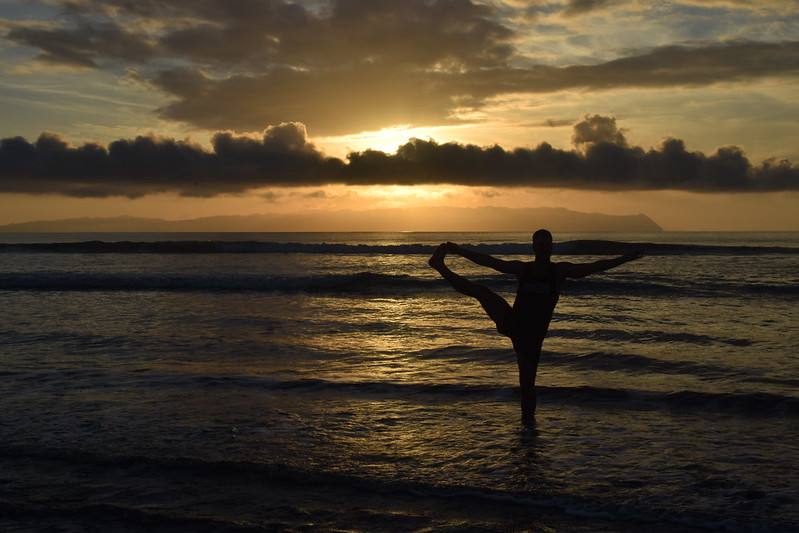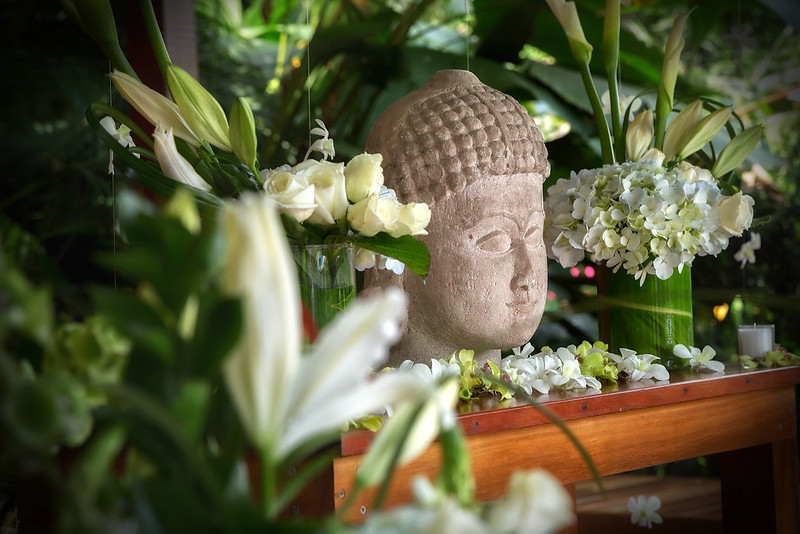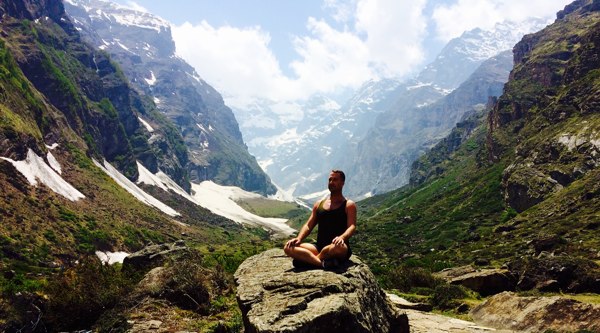Do you want to take yourself to the next level?
Are you ready to find out how to live a better and more complete life?
You can change your life significantly through the ancient science of the Yamas and Niyamas, knowing them and applying the art of journaling.
This will be a two-part blog, this first part focussing on the Yamas, and part two on the Niyamas, so stay tuned!

What are Yamas?
Yamas can be described as moral ‘restraints’. The Sanskrit definition of Yamas is likened to a barrier or putting a stop to something, similar to a container or a dam.
At Blue Osa we were having a problem with the surf, it grew a lot during the rainy season and would come crashing into the trees on the beach. Eventually, the trees got worn down and broke off into the sea. This prompted us to form a Yama of our own, gathering rocks and creating a rock wall to block the waves. Of course, the process was an experiment, and we learned through building the rock wall. It is the same in life, we need to develop practices to improve the flow of our life.
If you want to test the Yamas with someone take a long trip with them, the negatives within will begin to show themselves as uncomfortable situations reveal our darkness. This is likely why the ancient sages postulated the Yamas to begin with – they were walking for days together in the Himalayas and probably got so annoyed with each other that they had to name their frustrations!
The Yamas are important to help us unpack our mind and understand what is going on, what we are being triggered by and our habit patterns. In truth where your mind goes, you go. Our minds control us in this way, but it is possible for us to control our minds and therefore our direction in life.

The Yamas also dislodge the five causes of suffering in our lives.
The Five Yamas
AHIMSA
“How we treat ourselves is in truth how we treat others”
The first Yama in yogic philosophy is Ahimsa, which can be translated as non-violence. Consider what we can we do to alleviate the path of violence, the type of actions that prevent violence.
I believe that dynamic peacefulness is imperative for there to be non-violence. This means we have to act kindly towards people in distress and use joy and friendship with those around us. We have to learn to be equanimous with those who ruffle our feathers. Practice cultivating kindness and compassion for others and for yourself.
More than ever, we need to practice these elements of life so that we can live fearlessly. Fear binds us to a myriad of modes of suffering, causes terrible decision making and is what leads us to violence.
When we practice Ahimsa, we remove this fog of fear from our lives.
Journal Questions for Ahimsa
– What happens to you when you are kind to others?
– Do you wait for others to show you kindness first before you give it to them?
– How do you react when you feel afraid or threatened?

SATYA
“Truth rarely seems to ask the easier choice of us.”
The next Yama is Satya, which can be translated as a commitment to truth. It means you are genuinely authentic and truly know thyself.
Truthfulness also relates to non-violence because sometimes to be honest with someone you can cause harm – is that violence? Always consider the language you are using. Truthfulness prevents non-violence from being a cop-out and non-violence prevents truthfulness from being a brutal weapon.
It is important to tell the truth to others and yourself as lying creates confusion in the mind. For example, if someone asks “How are you?” you do not always have to brightly reply “I’m good” if that is not true. Instead, you can reply “actually I’m dealing with some anger at the moment” – that is being real rather than nice!
We also need to realize there is a difference between our personal judgments and the truth, and use language that identifies it as a judgment rather than the truth.
I often say that words carry power. Consider our political leaders, they carefully select their words in order to drive millions of people one way or another. In our personal lives, when we say one thing but do another we are creating karmic bondage that results in suffering and pain. This does not have to be the case. If we are sincere in our words, connecting to our truth and purpose with everything that we do, the world will be ours to enjoy!
Sometimes the truth is the difficult choice, but this is what builds character. Consider the people you look up to in life, the people you would like to do business with, usually you will find that they are truthful and sincere. Truth builds trust, and trust is the cornerstone of healthy relationships.
More than anything, always maintain a deep connection to your life’s purpose – this is the ultimate human truth.
Journal Questions for Satya
– In what ways are you living an inauthentic life?
– How could you live life more authentically?
– What strategies can you put in place to put the brakes on your judgments?

ASTEYA
“When we are engaged in the joy of life, we automatically serve the world rather than steal from it.”
Asteya is non-stealing, the practice of accepting that nothing is truly yours. This allows us to be in symbiosis with the world, as it is the essence of permaculture. When we practice giving without coveting possessions we turn everything around us into gems.
When I first started Blue Osa I had the intention to use agriculture to grow all the food that would be served here. I wanted to grow lettuce for salads and figured that we could make the soil here do that for us. I was so wrong. The lettuce did not grow like we wanted and we wasted thousands of dollars trying to force something the Costa Rican soil did not want to support. The Earth has it’s own natural process and I realize now that agriculture is like pillaging the Earth, it is the opposite of Asteya. Now at Blue Osa we practice permaculture, we listen to what the soil wants to support and we eat what it provides us naturally.
This is something we can engage in with all aspects of life. This produces joy because we are living from an abundance mindset, with gratitude and acceptance that whatever is given to us is perfect. We automatically serve those around us because we are not afraid that we don’t have enough, and we motivate others to practice giving through our example of contentment and gratitude.
Cultivate an attitude of gratitude for what you have.
Journal Questions for Asteya
– Where or what are you stealing to feel better about yourself?
– Does sharing come naturally for you?
– Do you easily share some things more than other things?

BRAHMACHARYA
“When gratitude and wonder sit in the heart, there is no need for excess.”
The next Yama is Brahmacharya, often defined as celibacy. I vehemently disagree with this definition. The actual Sanskrit interpretation is “Knowledge of the Creator” which I believe is indicative of contentment. When one has knowledge of everything, what more is there to grasp for?
The desire to chase after sense enjoyments like food, sex and sleep dissolve and we begin to cultivate sacredness in all that we do. We learn what gives us nourishment and what takes energy from us. We are able to identify when something is becoming dull and understand why that is a sign of excessiveness. For example, think about the difference in when you eat to the point of nourishment and satisfaction, versus when you eat to the point of excess and how that makes you feel.
We begin to honor all things as sacred, including ourselves. Brahmacharya is beautiful in this way, it is the recognition of our own divinity. And with practice, we begin to cultivate the divinity in others in the same way, always with love and integrity.
Journal Questions for Brahmacharya
– Where is dullness preventing you from experiencing the full expression of your life?
– When you enjoy excess what are you sacrificing?

APARIGRAHA
“Anything we cling to creates a maintenance problem for us.”
The final Yama is the most comprehensive, combining the elements of all the other Yamas. Aparigraha is the ultimate sense of identity, becoming completely satisfied with what and who you are.
This Yama is connected to the breath as when you can become deeply satisfied in your breath you discover there is nothing more important. If you do not fully let go of the exhalation the full nourishment of the inhalation is not available, holding on is a toxic action. Once you realize this you are able to fully enjoy things without needing more.
You become satisfied with things even if it was for the first and last time. You even become satisfied with things you don’t like! That’s a great one because many times, the best things for us are those that our ego does not like.
You live life with curiosity and non-expectation which dissolves negative habits and tendencies. You release a control mindset and live life surprised and delighted by its offerings, practicing generosity and trust. In the end, anything that we cling to becomes a maintenance problem for us. Aparigraha is the antithesis to this clinginess. It is the path that that creates the greatest joy for us in our lives.
Journal Questions for Aparigraha
In what ways does the need for possessions create a prison for you?
Where in your life can you have less, what can you let go of?

Summary of the Yamas
The Yamas are not simple answers, they are guides which used properly will help you to move in the direction of harmony. But it takes work! They require familiarity and daily practice.
Review of how they guide us:
– Non-violence guides us away from harming ourselves and others, towards kindness and compassion.
– Truthfulness guides us away from lies and half-truths to expressing our uniqueness and authenticity.
– Non-stealing guides us from theft to cultivating new skills and abilities.
– Non-excess guides us from greed to appreciation and pleasure without excess.
– Non-possessiveness guides us from attachment to intimacy without possession.
Live your life guided by these principles and watch how your life changes!


“As is the garden, so is the gardener”…. This is why there are ferns growing in and amongst potatoes and raspberries in my garden. I rather not have them there, but the ferns were here first, are somewhat rare, and are ancient, sacred to me. Agriculture , to me, is not as “pillaging” as you said in the Asteya segment of the Yamas as mining is. It can be, if in harvesting we take all of the yield of produce, seeds and all. Then there is nothing, seeds and or compost, to start with the next season. I have heard growing food in the tropics can be more difficult, due to insects and humidity. FYI: In the 1950’s , in the Dominican Republic, the president Truijillo invited Japanese farmers to emigrate to the D.R. and they began prosperous farming in the highlands of Hispanola, carrots and cabbage, strawberries, eggplant, etc. I learned that lettuce is too fragile for the 82F/28C to keep well. So everyone makes “salad” out of cabbage, marinating it oil and vinegar to make it soft like lettuce. I look to the example of “the Palace of Versailles, of how man then collectively tried at great length and cost to “tame nature” by creating an order and selection of which plants go “where”, so as to exemplify the idea of “man over nature”. That takes lots of extra work, and is still another illusion! Man will never conquer nature. But if we listen and learn , we can do less damage to it, still get what we need from it, time time to relax listening to nature’s symphony.
The Yamas are good to study. I did not know about them, before today, in this context. Thank you. Gracias